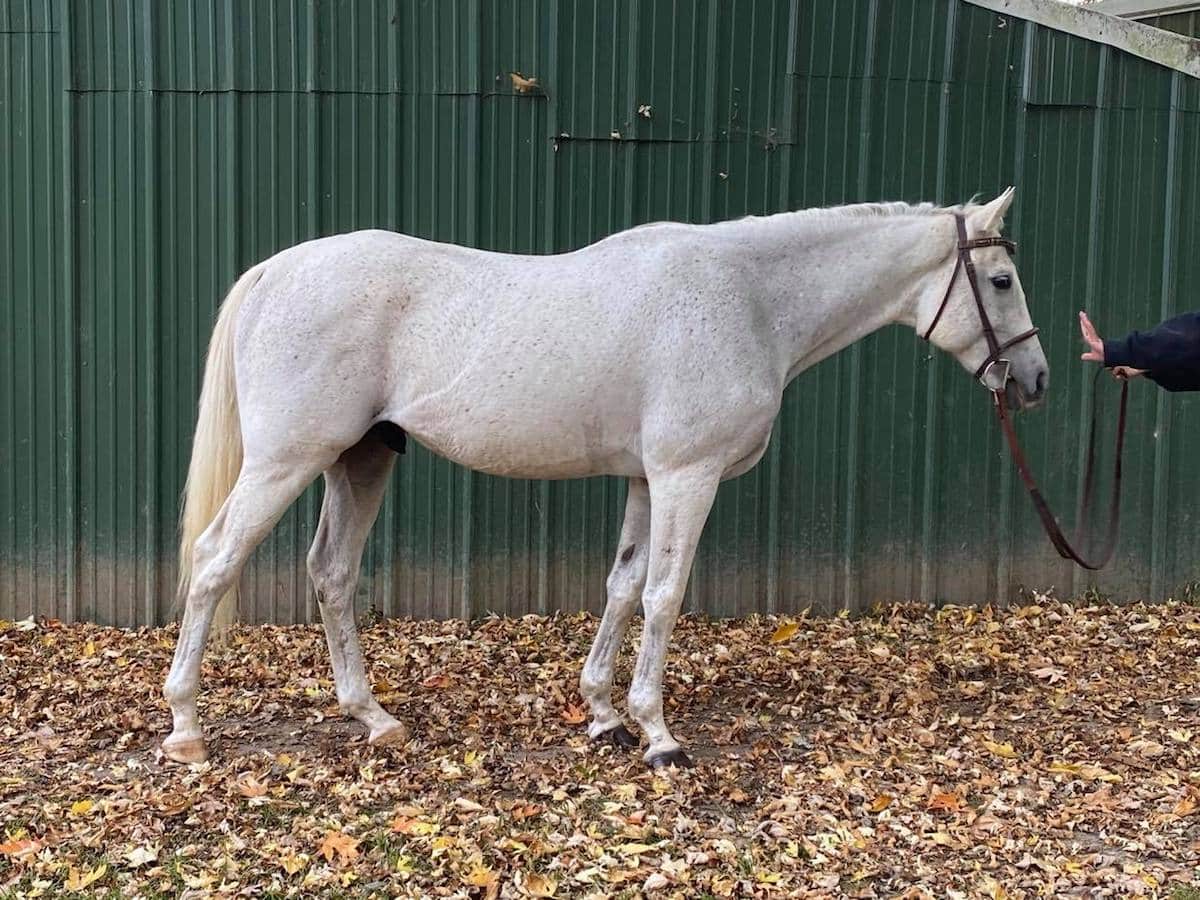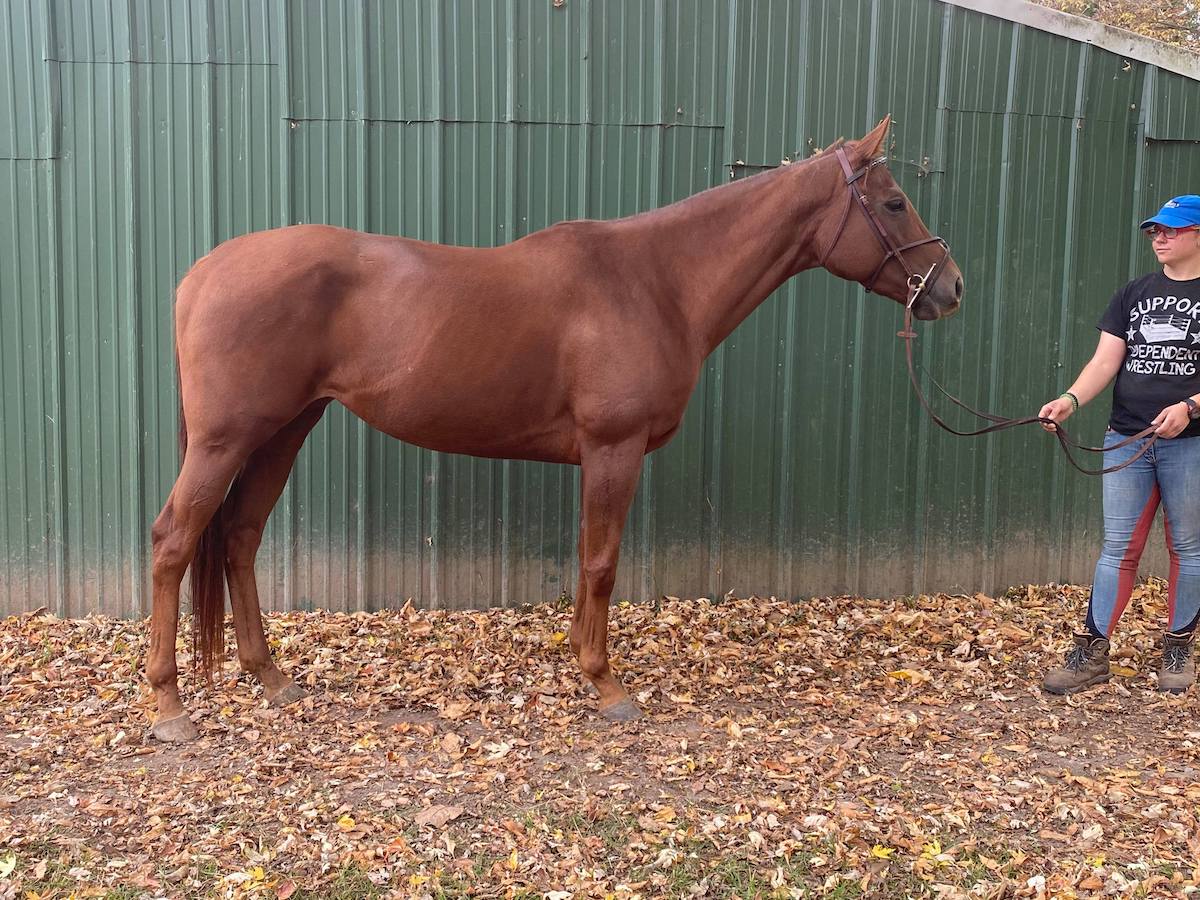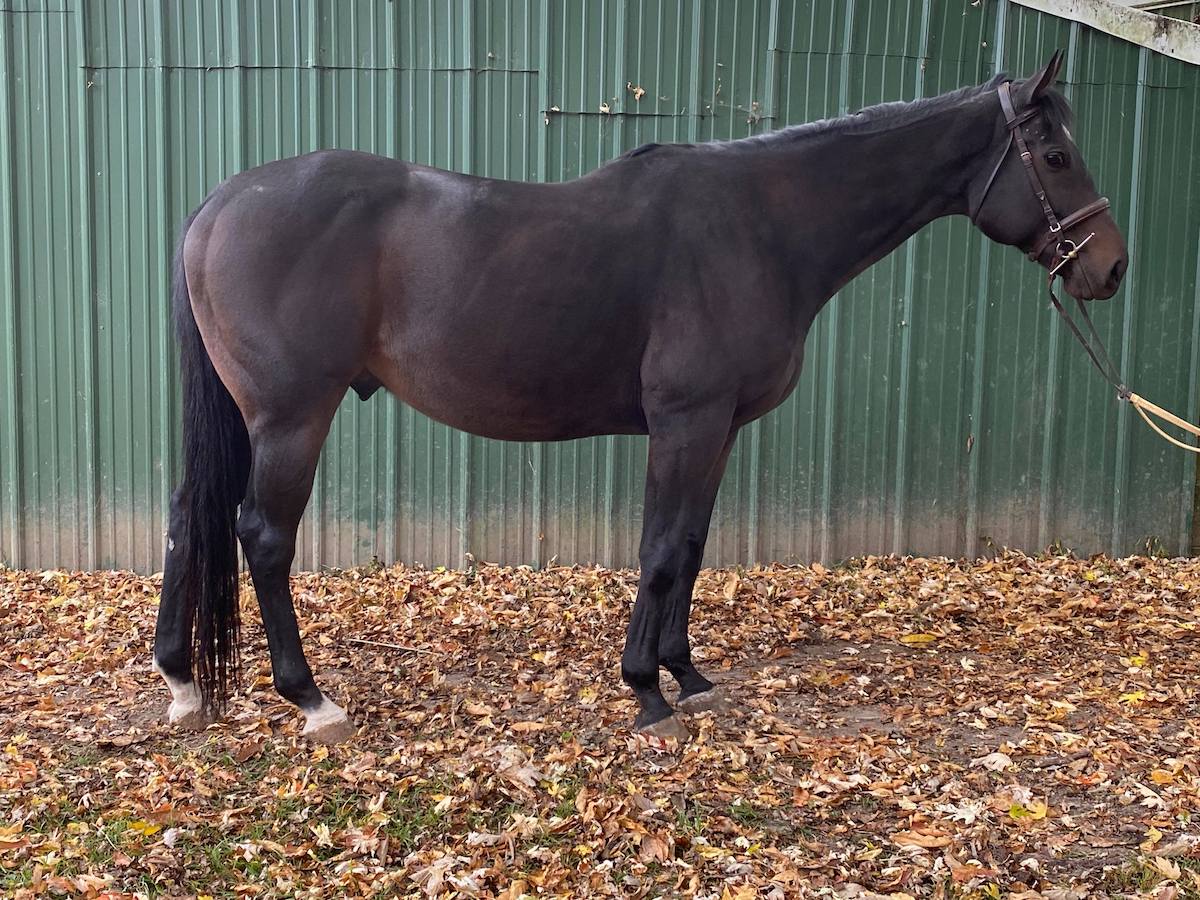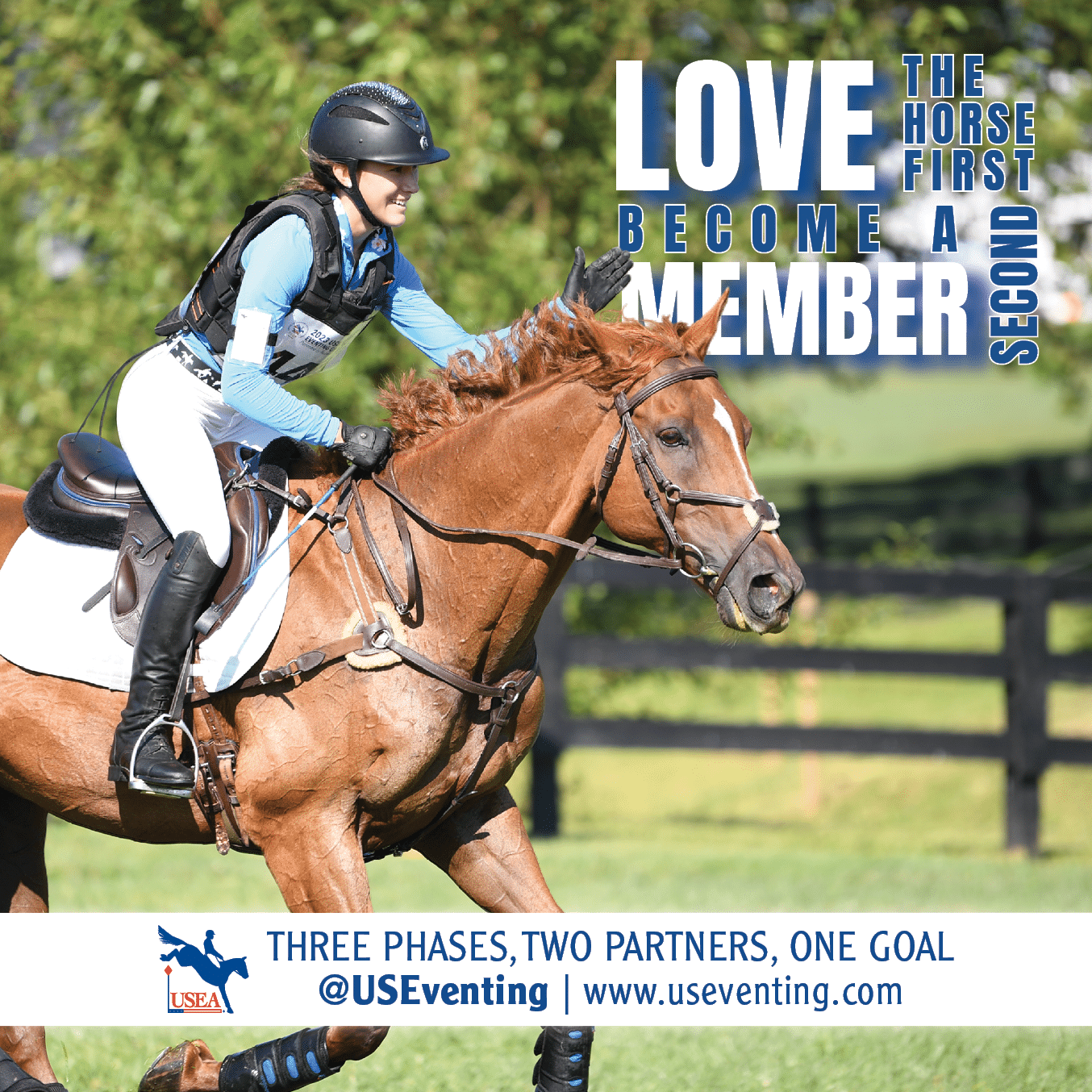Makeover trainers evaluate sport horse potential based on conformation shots
Social media has enabled potential OTTB owners to review a large number of retiring Thoroughbred racehorse listings at any given time. Newcomers to the breed might find it challenging to consider a prospect right off the track and decide if it’s a match for their desired purpose.
In this column veteran Thoroughbred Makeover trainers — professionals, juniors and amateurs alike — share their thoughts about assessing and selecting prospects and evaluate example horses based only on their conformation photos. We feature trainers from two disciplines in each issue.
Our Trainers
■ Amber Jacobson
Professional, winner of Ranch Work at the 2019 Thoroughbred Makeover with Silence Is Awesome
Jacobson has been in the Thoroughbred breeding industry for 11 years, working as a manager for several breeding programs before starting her own Running Fawcett Thoroughbreds Ltd, in Alberta, Canada, in 2012. She was a self-taught rider until she invested in more training in 2019 with working cow horse professional Kent Williamson. She now works as Williamson’s assistant.
■ Kendal Lehari
Professional, fourth place in Show Jumper at the 2019 Thoroughbred Makeover with Remember Gizmo
Lehari’s first event was at the age of 11, proving to be the launch of a career in eventing culminating in a top-20 finish at the Kentucky CCI**** in 2013 with her OTTB Daily Edition. She learned a lot as a young rider helping her mother leg up Thoroughbreds for the track outside of Toronto, Ontario. Lehari has served as the chef d’equipe for the Canadian Young Rider Team and is now transitioning into a director role with Ontario Eventing. She’s produced multiple OTTBs to the upper levels in eventing.
Choosing a Horse
Both Amber Jacobson and Kendal Lehari have personal connections to the Thoroughbred racing industry, which helps them source the horses they transition to second careers. As a breeder, Jacobson keeps tabs on all the horses she’s bred and, to date, all of her Thoroughbred restarts have been her homebreds. Lehari’s main source for off-track prospects is a family friend who’s familiar with the kind of horse she seeks.
“In the best case, a horse I’m looking at for myself will be a good mover, great jumper, sound and have the heart to make it to the upper levels of eventing,” Lehari says. “It’s hard to know if they fit those requirements when I can only see them jog at the track, so I have to have resale value in mind.”
For her that means a big-boned Thoroughbred, typically a gelding with no vices, around the age of 3 with a light racing career, no previous injuries, straight-legged with good feet and a kind eye.
While Jacobson is looking for ranch-type horses, her criteria are remarkably similar: She likes a heavier-boned horse with good feet and straight legs with a pretty head and soft eye, ideally with no major injuries.
“It’s easiest to resell a bigger gelding with a little bit of chrome … but I also like a saucy chestnut,” she says.
Jacobson also looks for short cannon bones, a shorter back and generally a shorter horse — ideally, she likes her mounts to be 15.2 hands or smaller. “None of this I put to a golden rule, however,” she adds, detailing that one of her favorite restarts was a 16.3-hand mare with bench knees who toed in.
Meet the Prospects
Our model horses come from Friends of Ferdinand, based in Indianapolis, Indiana. Launched by racing fans who sought to protect racehorses from entering the slaughter pipeline, Friends of Ferdinand’s goal is to assist Thoroughbreds as they transition to second careers so they might lead long, full lives after racing.
Friends of Ferdinand works with retraining facilities across Indiana and Ohio. Racing connections donate horses to the program, which come directly to the retraining facilities from the racetrack. Horses are vetted, evaluated and placed with one of the English or Western trainers for basic restarting before being listed for adoption. The program also assists owners who are looking to place Thoroughbreds already in their second careers. Approved adopters are required to take a test ride and then receive a 30-day trial period to ensure a good match.
While these three horses might no longer be available for adoption by the time this magazine hits your mailbox, Friends of Ferdinand has plenty of prospects looking for their next partners.

1: Durazno (Three Wonders — With Zest, With Approval) Courtesy Friends of Ferdinand

2: Return Tothe Skies (Mondavi — Return To Flying, River Flyer) Courtesy Friends of Ferdinand

3: Western Reserve (Indian Charlie — Visit [GB], Oasis Dream [GB]) Courtesy Friends of Ferdinand
Jacobson’s Picks
Horse 2: The chestnut looks bright and aware. She has a good slope to her shoulder, a lower wither and a flatter back than the other two. Her front legs stand straight under herself, suggesting a long stride as well as ability to do the lateral movements required in cow work. From this single photo it’s tough to judge her hind end, but I feel that there aren’t any conformational weaknesses here — just a need for conditioning for a second career. She may be slightly sickle-hocked, but that’s not necessarily a flaw in my mind, as it does make it easier for a cow horse to get her hind end beneath herself for a turn or rollback. If I drew a box around this horse’s body and legs, it would almost be a perfect square, which indicates balance.
Horse 1: This guy says hunter all over! If I had to guess his personality from looking at his head, I would say he would be gentle and willing. He has great bone and decent feet. If I had a magic wand, I would add a bit of length to his neck, but generally he looks very well-proportioned. Going back to the box I mentioned for Horse 2, this horse also demonstrates almost a perfect square, and I would guess that he is a smooth and balanced mover.
Horse 3: This horse actually has my favorite hind end out of the three: His hocks are a little straighter and look more developed at this stage of this horse’s retraining. From the overall look of this horse, he may have been retired the longest of the three and is probably ready to go to work if he hasn’t already. Up front he’s a little straight in the shoulder for my liking, but I do like his short cannon bones. He’s a little longer than he is tall, but he has an “old soul” look about him — I think he would make a great all-around kind of horse.
Lehari’s Picks
Horse 1: Overall, I want to mention that I’m very impressed with how good all of these horses look. They have good weight and look happy and healthy and well-loved. This gray horse looks like an amateur’s dream. He has good bone and good feet and, overall, a solid look with a kind eye. His short back suggests that he would be easily adjustable, and I think he would hold up well to eventing. He looks like he should be smooth to ride and has the appearance of a forgiving type of horse.
Horse 3: This horse has a nice expression with a kind eye. He’s also blessed with good bone and good feet. I particularly like his hind end, which looks powerful, suggesting plenty of push from behind, which can translate to a good jump. He’s a bit longer-backed than the other two horses, which may make him a little harder to collect and package up but can also make him really scopey over the fence. I’d love to see what this horse looks like a year from now with some topline work — I bet he would look a lot like a Warmblood.
Horse 2: Like the other two horses, this horse appears to have good feet and definitely has a good expression and kind eye. She’s slightly finer built than the other two, which isn’t necessarily a bad thing; it’s just not my personal preference. This horse might be a diamond in the rough — with a year or two of conditioning work to strengthen her hind end, she may look very different. This is the kind of horse who just needs remuscling in different places in a second career.
This article was originally published in the Winter 2021 issue of Off-Track Thoroughbred Magazine, the only publication dedicated to the Thoroughbred ex-racehorse in second careers. Want four information-packed issues a year delivered to your door or your favorite digital device? Subscribe now!

